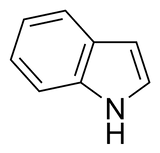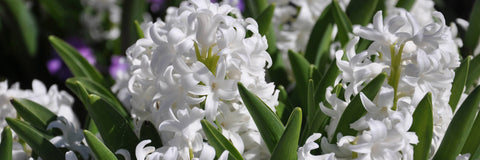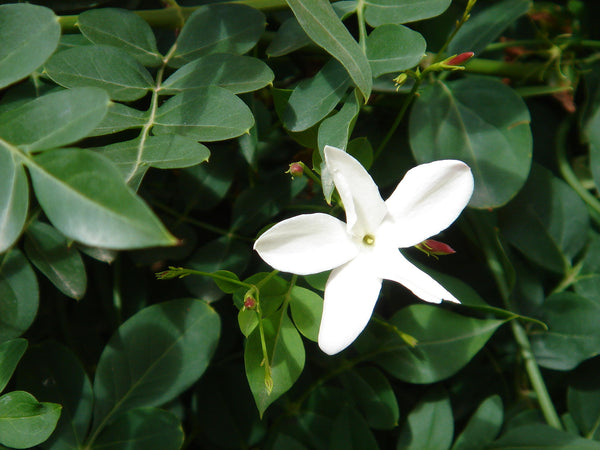
What gives florals their seductive power?
Let me introduce you to a little compound called indole.

Indole is, by definition, an aromatic heterocyclic compound which contains a six-membered benzene ring, fused to a five membered nitrogen-containing pyrrole ring.
If that doesn’t mean much to you, here’s the what you need to know; it smells.
Perhaps poop isn’t the best description for indole. In its pure, isolated form, Indole is more like musty, wet, yet also a penetrating sharp-clean smell. A sort of odd combination of wet-dog, stale hot breath and moth balls all rolled into one.
Yes, this compound does contribute to the smell of feces ( mixed together a cornucopia of other things ) but trace amounts are also founds in “White” florals, like Jasmines, Tuberose, Neroli, Orange Blossom Gardenia, etc. What really creates the signature aroma of #2 is really when high concentrations of indole are mixed with humidity and the surrounding decaying molecules found in poop.
Here’s the interesting part -
In trace amounts ( around 1% ), the stench of pure indole actually mellows, loosing the mustiness and becoming more “floral”, more ambient. In fragrances, natural oils that contain indole are often used to bring intrigue and a seductive edge to a scent. Providing an indescribable, underlying “animalic” note that allures to the primal senses, similar in a way to how pheromones work. When it comes to fine natural fragrances, indole serves a new purpose.
It seduces.
I am a little embarrassed to write this, but poop can be sexy. It’s similar to being in a public restroom and having the unfortunate experience of smelling someone else’s last ‘performance’. It’s repulsive and unfriendly, but at the same time a small part of you is extremely curious, a little intrigued in a primal way- a “what IS that? What did they eat? Do I smell like that?“ sort of way.
It’s biological- look at animals. Anyone who has ever lived with dog will tell you that they sniff poop. This helps them gain information about who this dog is, what they ate, are they healthy enough to mate with, etc. This sort of poop-information-finding technique rings true though many mammals.
White Florals are dirtiest.
White florals are just that - white. Gardenia, Jasmines, Hyacinth Tuberose, Orange blossom and her bitter brother, Neroli all fall into this category of being extremely rich in indole. However a few other friends in the flower kingdom also hold trace amounts of the compound, such as rose, lilac and honeysuckle.
Jasmine, however, might be the dirtiest.
The essences of Jasmine, particularly the variety Jasmine Grandiflorum, is notorious for having a noticeable, STRONG indole note ( most jasmine oils contain around 2.5% of the pure stuff ). By no means do it smell like sniffing a toilet, but when faced with a pure jasmine oil, indole does bring a very noticeable wet- mustiness, much like dirty, sweaty skin mixed into the narcotic floral-sweetness of fresh jasmine blooms.
It’s unnerving in a way- it really makes you question you perception of scent and what is true. But this is where dilution makes things interesting:
As I stated above, pure jasmine oil is roughly 2.5% pure indole. That's a noticeable amount to any nose.
But, think of the last time you’ve walked by blooming jasmine ( or even smelled a white lily or wild honesuckle ). The scent is very pleasant, sweet, floral, seductive. Indole is in there, but in such an incredibly small amount, that it only adds a seductive, alluring, “alive” quality that you come to associate with florals. There's nothing toielt-y about it.
Now take about 10,000 lbs of those jasmine flowers, and concentrate them into 2.2lbs of oil. All the same fragrant molecules are there, just much more concentrated. With indole being present at a more condensed level, the sexy sultry edge of fresh flowers become muddled with a much mustier, dirty undertone. The key to indole's seduction is in dilution.
This concept of concentration holds true with all fragrances- you’ll never be wearing pure jasmine oil ( the sheer cost alone would be enough to deter you ). Pure materials are diluted among others fragrant oils and natural bases to create something fresh and truly floral. With dilution, the pure essences are received by the nose as they are meant to be smelled. The role of Indole becomes much more of a silent actor while simultaneously being the one responsible for breathing ‘life’ into the perfume.
Jasmine Grandifloum
Sexy Sweaty.
Something you learn very quickly when working with pure natural compounds is that nothing smells like what you imagine. Your perceptions of natural scent ( synthetic fragrances are a whole different story ) are all pulling from experiences out in nature- a cedar tree you walk by, a rose in a garden, etc. These fragrances are diffused in the surrounding air, creating a pleasant scent that you are most familiar with. Concentred down to its pure form, the aromas are generally transform into something much more harsh and sometimes surprising, like the case of indole in jasmine.
I remember when I first smelled real Jasmine Grandiflorum *. I bought a small sample from my favorite natural oil supplier, open the cap and.. Sex. It smelled very dirty, like stale sweaty skin, slightly floral and sweet, mixed with a the peculiar scent of an overripe banana. I was repelled… but curious enough that I came back to it a few weeks later. I applied some diluted oil to my skin and it was hypnotic. I found myself still continually smelling my wrist, not because I was in love with the fragrance, but I felt drawn to it like a magnet. There was something so off... but so familiar that I couldn’t put my finger on that brought me back to it time and time again. To this day I am still not a huge fan of Jasmine Grandiflorum ( I prefer to use it’s night-blooming brother, Jasmine Sambac with a much darker, greener profile ), but I sometimes find myself sniffing this oil just to get a whiff of it’s strange, seductive, heady aroma.
*There are 2 main types of jasmine extracts that are weirdly used by natural perfumers; j.grandiflorum ( blooms in the day ) , j.sambac ( Blooms in the night ). Jasmine Sambac has a much darker, ‘green’ leaf-like, ethereal floral quality that I prefer to use in my creations.
Indole and Serotonin
Perhaps the most interesting thing about Indole is its relationship to Serotonin.
Indole is an intermediate that helps compose the the amino acid Tryptophan. Tryptophan is a precursor to the calming neurotransmitter serotonin. In short, the “indole ring”, as described in the beginning of this article, is found in the calming/happy serotonin chemical, also found in anti-depressants and foods like chocolate, dairy products and pumpkin seeds.

Try It:
As I write this, I'm sitting next to blooming hyacinth, a very strongly scented flower with a noticeable musty idole note.
Buy a bouquet of Hyacinth and allow them to bloom. As their blossoms start to age, you will begin to notice a very strong, sweaty musty note develop, mixed with the sweet floral fragrance. That scent is indole.
For the indole-adverse Crowd
There are non-indolic white floral scents out there- however they are not natural. Synthetics can be synthesized without the indole compound or naturals can be fractionated to have the indolic compound removed. All equally floral in their own right, however they tend be a little flat and dry. That special, sparkling, life-like quality that REAL flowers exude is lost with the inclusion of our peculiar friend, Indole. So let’s appreciate him for all the life that he brings to the party.
Dirty, musty, and full of life. Thank you indole.


Comments